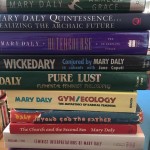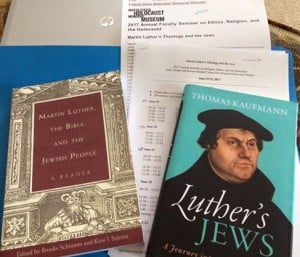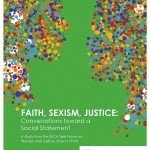The following is an excerpt from a piece that my husband, Mark Schelske, wrote over at Fantasy Matters last week. It’s his take on why I love The Wizard of Oz, and he makes a connection between that love and my second book, Two Reformers.
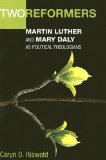 In sum, Caryn’s book compares a 20th century feminist academic, Mary Daly, to a 16th century Catholic priest, Martin Luther. They both leave the Catholic Church and lead reformist movements after being disillusioned by their experiences in Rome. For Daly, women are completely excluded, and for Luther, he sees the corrupt practice of selling indulgences for salvation. It’s this pilgrimage to a holy destination and the corresponding discovery of a falseness that I relate to the journey of discovery along a yellow brick road. Daly and Luther saw behind the curtain. If the church cannot reform itself, then exodus is required.
In sum, Caryn’s book compares a 20th century feminist academic, Mary Daly, to a 16th century Catholic priest, Martin Luther. They both leave the Catholic Church and lead reformist movements after being disillusioned by their experiences in Rome. For Daly, women are completely excluded, and for Luther, he sees the corrupt practice of selling indulgences for salvation. It’s this pilgrimage to a holy destination and the corresponding discovery of a falseness that I relate to the journey of discovery along a yellow brick road. Daly and Luther saw behind the curtain. If the church cannot reform itself, then exodus is required.
Indeed, The Wizard of Oz is an inspiration for my wife’s career as a feminist theologian in the Lutheran tradition. Caryn is like Dorothy; she sees men behind a curtain that are working levers to manipulate believers. Caryn cannot accept this reality because she demands that Dorothy be treated as an equal in the Emerald Church.
And Dorothy, I believe, is Caryn’s subconscious metaphor for the ideal coming of a messiah. Evil is not confronted with a great battle, an army, or death by a sword. Dorothy’s triumph over the first wicked witch is via innocence: her house smothers evil. After all, Dorothy doesn’t want to harm anyone, or to take the spoils of victory which in this case are ruby slippers.
 Moreover, Dorothy is someone who is sincere, nice, independent, and fights against injustice without using weapons. She has faith in others, and gathers four disciples on her way to the Emerald City. They all may believe in the Wizard of Oz because of all the wonderful things he does, but it’s Dorothy – not Oz – who brings salvation from the second wicked witch with a baptism of water.
Moreover, Dorothy is someone who is sincere, nice, independent, and fights against injustice without using weapons. She has faith in others, and gathers four disciples on her way to the Emerald City. They all may believe in the Wizard of Oz because of all the wonderful things he does, but it’s Dorothy – not Oz – who brings salvation from the second wicked witch with a baptism of water.
I think I will go so far as to say that for Caryn, Oz represents the domination of patriarchy. It’s informed her politics, because Oz is assumed to be great and powerful, whereas Dorothy is not. And it’s why she a huge fan of any spin-off that continues the fight against patriarchal thinking which denies the power of women.
In Wicked, the Wizard of Oz is a slime ball. He has a crusade against magical animals. And he seduces a munchkin and gives her an elixir that affects her subsequent pregnancy and turns her daughter green. Thus, we have the patriarch interfering with a woman’s reproductive health.
Even in a world with witches, patriarchal thinking leads Glinda the Good Witch to work within the system, rather than oppose it. So, in fact, the woman who stands up to Oz is labeled as wicked. Thus, everyone is terrified with that feminist, that “other” with green skin.
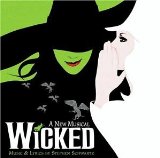 So Dorothy demonstrates the power of women in The Wizard Of Oz, and the witches come to the fore in Wicked. But then comes the recent movie: Oz The Great And Powerful, and though it’s a huge role reversal with a man in the lead role, patriarchy is exposed once again.ven in a world with witches, patriarchal thinking leads Glinda the Good Witch to work within the system, rather than oppose it. So, in fact, the woman who stands up to Oz is labeled as wicked. Thus, everyone is terrified with that feminist, that “other” with green skin.
So Dorothy demonstrates the power of women in The Wizard Of Oz, and the witches come to the fore in Wicked. But then comes the recent movie: Oz The Great And Powerful, and though it’s a huge role reversal with a man in the lead role, patriarchy is exposed once again.ven in a world with witches, patriarchal thinking leads Glinda the Good Witch to work within the system, rather than oppose it. So, in fact, the woman who stands up to Oz is labeled as wicked. Thus, everyone is terrified with that feminist, that “other” with green skin.
Oz is a charlatan. He does magic tricks for a living, and causes a little girl in a wheel chair to beg him to heal her. He seduces women with a lie about a music box. It’s not a very nice view of the masculine. And his lies come back to haunt him in Oz. Theodora represents the scorned woman. Her older sister Evanora represents Oz’s temptation for the corrupt acquisition of riches. And even Glinda the Good Witch is a reflection of the successful woman who Oz is afraid to love, since she reminds him of his failings. He is a false wizard, but in discovering his heroic masculinity of fighting for justice, he becomes great and powerful.
And I believe the same lesson of heroic masculinity is learned in The Wizard of Oz. The Scarecrow doesn’t have a brain. He’s clumsy, always falling, and always harmless. The Tin Man is a dependent. Without Dorothy to oil him, he’s useless. And although he has an ax, the only weapon in Dorothy’s entourage, the Tin Man lacks any violent tendencies. The ax is a tool, nothing more. He’s even too afraid to use it in the Dark Forest. And the Lion, a symbol of man’s ultimate virility, is in fact a total coward. This view of the masculine is non-threatening and docile. Qualities that patriarchy does not value. Yet the Scarecrow, Tin Man, and the Cowardly Lion fight for justice. And thus, they find redemption with a new brain, a new heart, and a new form of courage that redefine masculinity. And it is Dorothy who helps them develop their masculine selves.
Again, my point to all this is that fantasy matters. For Caryn, I think, The Wizard of Oz (and Wicked) celebrate women. The heroic leads are for women, the best songs are by women, and the story lines are about the power of women.
What a gift when your beloved knows you so well. For more of Mark’s writing, head on over to Fantasy Matters.



